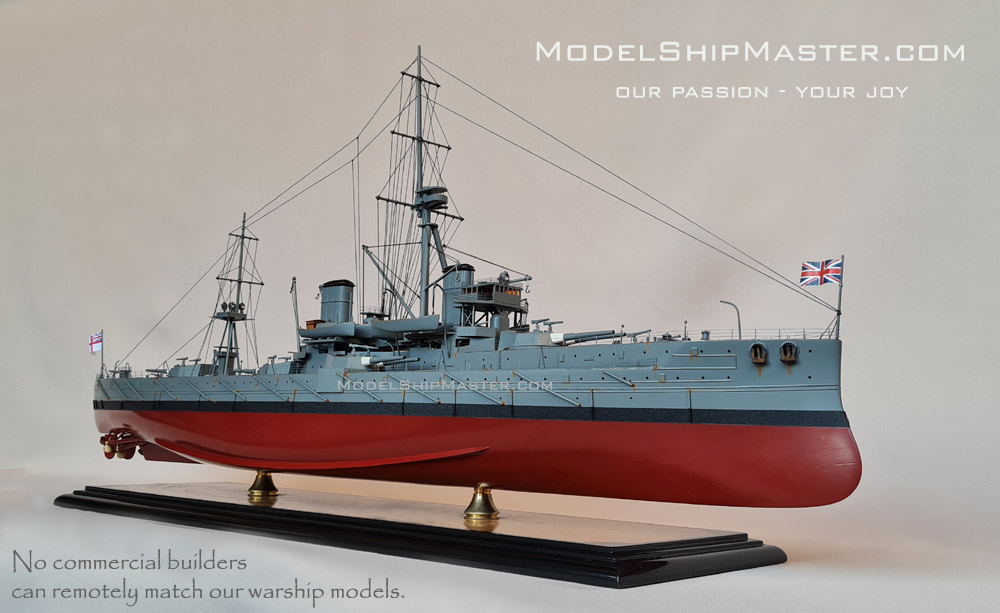|
HMS DREADNOUGHT
HMS Dreadnought was so advanced that her name became a
generic term for modern battleships, whilst the
ships she made obsolete became known as
"pre-dreadnoughts." From 1906,
the world’s battle fleets officially were divided into
Dreadnoughts and pre-Dreadnoughts.
.jpg)
HMS Dreadnought was the
first battleship of her era to have a uniform main
battery, rather than having a few large guns
complemented by a heavy secondary battery of
somewhat smaller guns.
In the
late 1800s battleship designs generally featured
large guns mounted in turrets or barbettes located
fore and aft, with the sides of the ship mounting
many smaller caliber guns whose high rate of fire
could shower the enemy with small but damaging
shells. There was no effective fire control system
however, and the effective range of all of the guns
was rarely greater than 2,000 meters.
Long range
gunnery testing led officials to develop a fire control
system where the splashes of the shells around the
target were observed, with minor gunnery changes ordered
accordingly. Testing revealed that using that method
increased the practical range of the guns to 7,000
meters. It did create a new problem however – how to
differentiate between the splashes of the large and
small guns? Gunnery observers onboard the ship wouldn’t
know which splash belonged to which gun, and thus not
know which guns to adjust.
In 1903
the chief designer of the Italian Navy, Vittorio
Cuniberti, proposed to solve the problem by arming
battleships with a single caliber of large gun. While
his ideas fell on deaf ears within the Italian Navy,
officials in the Royal Navy, particularly Jackie Fisher,
had been considering the same idea. In 1904 Fisher
became the First Sea Lord, then the most powerful
position in the Royal Navy, and immediately began
pushing for a new class of battleship armed with an
“all-big-gun” armament. He claimed he could design a
ship armed solely with 12” guns and capable of a speed
of 21 knots - and deliver it in less than a year.
In
parallel with the armament development, Fisher pushed
for steam turbine propulsion, a then-young technology
that showed great promise but had yet to sway the Royal
Navy brass. The system had many advantages including
reduced cost and weight, higher reliability, and better
fuel efficiency. They operated best at high speeds
however. In fact, to operate properly at low speeds,
four propellers were required, negating some of the cost
and weight savings. For his new battleship design
however Fisher demanded that they be installed.
Construction of the new ship began in October 1905. The
HMS Dreadnought was launched just four months later,
though fitting out took another ten months. Her fourteen
month construction time remains a record for a ship of
that size and was roughly half as long as it took to
normally build a battleship.

When commissioned the
HMS Dreadnought was the largest battleship in the
world, displacing 21,845 tons fully loaded. She was
armed with ten 12 inch guns in five turrets, three
on the centerline and one on each side. This
configuration gave her twice the firepower of any
other ship then in service. She could also control
those guns with a new centralized fire control
system that allowed all the guns to be fired at the
same target, unlike previous designs that featured
local control of each gun turret. HMS Dreadnought
rendered all other ships obsolete. Jackie Fisher
stated that compared to the Dreadnought, all other
ships could neither fight nor run away.
On 18 March 1915,
HMS Dreadnought became the only battleship to sink a
submarine during the First World War. The Grand
Fleet was at sea conducting tactical exercises, when
U-29 fired a torpedo at the fleet. Dreadnought
sighted the submarine, and a chase began. After ten
minutes the Dreadnought rammed the submarine, which
sank with the loss of all hands.
The end of
the “War to End All Wars” brought with it heavily
reduced defense budgets around the globe. The Royal
Navy’s aggressive ship building program was scaled back,
and the HMS Dreadnought herself became a victim of the
cutbacks. Broken up and sold for scrap in 1921, it was
an ignominious end for one of history’s most
revolutionary ships.

.jpg)
This primarily
wood HMS Dreadnought
model is 32"
long x 14" tall x 7" wide (1/200 scale) $3,290
Shipping
and insurance in the
contiguous USA included. Other
places: $350 flat rate.
Model is built per commission only. We require only
a small deposit to start the process. Please click here for
more details.
Click here to
learn about authentic
warship
models.

Learn more about the HMS
Dreadnought here:
https://en.wikipedia.org/wiki/HMS_Dreadnought_(1906)
|